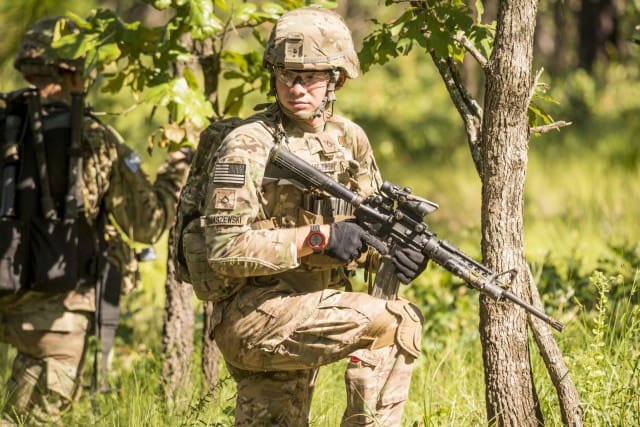NATICK, Mass. – The U.S. Army Combat Capabilities Development Command, or DEVCOM, Soldier Center, working in conjunction with academia and industry, has developed the Fragmentation Rapid Analysis Generator using Computed Tomography, or FRAG-CT.
“FRAG-CT supports the Army Chief of Staff’s priority to better protect the warfighter in current and future combat situations,” said Lisa King-Schiappa, the Protection Technology Development team lead in the Protection Systems Division, Soldier Protection Directorate, at the DEVCOM Soldier Center.
King-Schiappa explained that the “FRAG-CT analysis tool has matured into a stand-alone Graphical User Interface, or GUI, that streamlines the gathering of valuable munition fragmentation data from indirect fire arena tests.”
The method produces a data file of the munition fragmentation characteristics along with a data file used for armor design and also distinct 3D files of each individually scanned fragments for follow-on future analysis. FRAG-CT makes it possible to process arena test bundles up to 200 times faster than current hand-count methods. This new methodology can decrease bundle analysis time from months to hours.

“Timely, accurate and repeatable evaluation of indirect fire threats are critical for developing new armor designs and expeditionary protection systems,” said King-Schiappa. “FRAG-CT is the solution to time-consuming and unreliable fragment hand-count data.”
“The FRAG-CT analysis tool streamlines the gathering of munition data,” said Tom Reynolds, Protection Systems Division leader, Soldier Protection Directorate, DEVCOM Soldier Center. “This tool is less time-consuming and more reliable than other methods and will aid in the development of improved armor design.”
To develop FRAG-CT, the Soldier Center collaborated with a number of agencies, along with its development partner Compotech, headquartered in Brewer, Maine, and a CT scanning expert at the University of Maine.
“The collaboration with the National Ground Intelligence Agency, DEVCOM Army Research Lab, DEVCOM Data Analysis Center, DEVCOM Armament Center, Naval Surface Warfare Center, Compotech and UMaine was significant in the development of FRAG-CT,” said King-Schiappa. “The team was comprised of subject matter experts in the fields of threat assessment, munition exploitation, armor design, CT scanning and expeditionary ballistics – these critical aspects support the rapid development of an improved methodology for armor design.”
In addition to protective equipment, FRAG-CT may also aid in munition development.
“Warhead development is an iterative process from design to prototype to testing and back to design,” said Henry Hsieh, mechanical engineer, DEVCOM Armament Center. “This process is often cost prohibitive due to the time and labor required to collect and analyze vast amounts of data after a destructive warhead event. The FRAG-CT technology has the potential to minimize or even eliminate the laborious process of manually picking, cleaning, weighing and sorting tens of thousands of fragments after each warhead test, drastically reducing labor cost as well as data turn-around time. With this technology in place, warhead developers can rapidly and confidently design munitions adapted for our next generation of warfighters.”
Data collection and analysis play an all-important role in DEVCOM Soldier Center’s commitment to advancing capabilities and technologies for the Soldier.
King-Schiappa noted that software technology and analysis capabilities associated with FRAG-CT will also help address mission priorities that emphasize increased maneuver and lightweight expeditionary ballistic protection — thus, delivering protective expeditionary maneuver systems and Mission Command Technologies into Soldiers’ hands more quickly to increase warfighter readiness.
“Threats of interest are ever changing,” said King-Schiappa. “The Army is working diligently to narrow the capability gaps that affect Soldiers and enable the rapid delivery of capabilities to the warfighter. FRAG-CT enforces the aspect of rapid delivery for ongoing threat characterization work.”
The DEVCOM Soldier Center is transferring the software technology and the analysis capability to both the DEVCOM Army Research Laboratory and DEVCOM Armament Center.
DEVCOM SC, DEVCOM ARL, and DEVCOM AC have signed a software use agreement, or SUA, that is emplaced for work to support both arena-test methodologies and water-test methodologies using FRAG-CT. This GUI and upgraded test methodology will enable DEVCOM AC and DEVCOM ARL to process arena- and water-test data with greater accuracy, speed and repeatability.
“FRAG-CT is a state-of-the-art software package that allows the user to quickly and accurately process large amounts of fragment data under one platform,” said Justin Pritchett, a mechanical engineer at the DEVCOM Army Research Laboratory. “It has a multiple-input, multiple-output capability that supports data input from different types of fragmenting munition experiments and outputs various data formats for modeling and simulation codes. This technology advancement will drive how we process and collect large data sets in the future.”
King-Schiappa explained that the methodology and GUI may also feed modeling and analysis efforts tied to software such as the Advanced Joint Effectiveness Model, or AJEM. AJEM is a survivability, lethality, and vulnerability computer simulation code that is capable of analyzing one or more threats attacking one or more rotary-wing or fixed-wing aircraft, small watercraft, ground-mobile system, and mounted or dismounted personnel.
Mike Maffeo, a senior engineer on the Ballistic and Blast Protection Team, Protection Materials Division, Soldier Protection Directorate at the Soldier Center, explained that there are other models in addition to the AJEM model that can also use this data, including a casualty software called the Integrated Casualty Estimation Methodology, or ICEM, model.
Maffeo, who serves as the model manager for ICEM, explained that ICEM was developed specifically to model dismounted soldiers and the body armor they are wearing.
Maffeo believes that FRAG-CT is an important innovation in fragmentation data collection and analysis.
“FRAG?CT looks to be a real game changer in getting new fragment files quickly for armor assessment and vulnerability analysis,” said Maffeo. “With all the data that is being collected by FRAG?CT, it opens opportunities to increase the fidelity of the modeling and analysis. Some of these newer munitions have asymmetric (non?symmetric) burst patterns that are difficult to model without the right data. FRAG?CT should allow us to get this type of data quickly.”
In the future, FRAG-CT may also have applications for Elastic Plastic Impact Computation, or EPIC, and beyond.
By Jane Benson, DEVCOM Soldier Center Public Affairs

